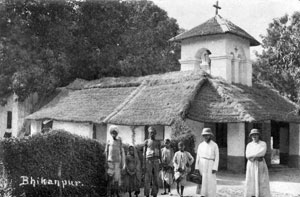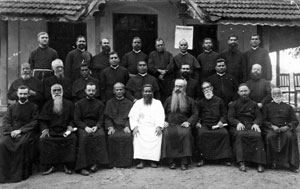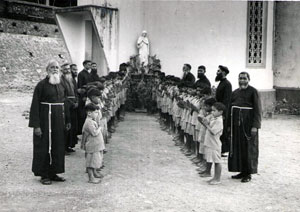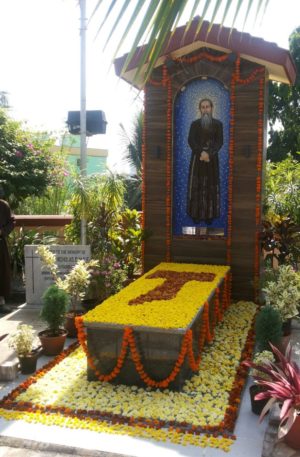It was in this context that the Nagpur group ventured a break with their Lahore counterparts. They dared this breach on ideological ground based on the vision of Bodewig which drew them to his band of followers. They wanted to be true to the original aim of their movement. The breach happened in February 1902. And thus, the Nagpur group of Brothers decided not to have any ties with the Brothers at Lahore. The Nagpur group decided to form themselves into a separate congregation and Bro. Paulus Moritz was selected as their new Superior General. From Nagpur, the Brothers moved to Nimar district of the Central Province, with Khandwa as the center of activities and the journey continues to this day.
The first Mother house of CMSF was erected at Khandwa, Madhya Pradesh, in 1908 and the brothers started their work at Mount Poinsur, Borivali west, in the Archdiocese of Bombay from 1930, and after the first General Chapter, the Mother House along with the Generalate were shifted to Mount Poinsur. The revised constitutions were approved by the Holy See on 29th June 1931, and again renewed and updated in 1985 during the IX General Chapter, and in 2009 during the XIII General chapter respectively, and has been approved by the HOLY See.
The Congregation was founded specifically to evangelize India, to present Jesus Christ to the masses of India. The charism of the Franciscan Missionary Brothers is that of being PIONEERING MISSIONAIRES. This notion or concept is derived from the nature of the work the Congregation had been doing from the beginning of its inception. The founder saw the role of the Brothers as Pioneers in the Mission Field: “that is to say, retaining the lay charism, the Brothers are to be the vanguards, the forerunners, the ground breakers, the heralds of the Gospel, a role akin to that of St. John the Baptist in the life of our Lord Jesus Christ. Once the ground has been prepared, once the seeds of faith have been sown and their germination begins, the Brothers would move on to other areas unreached by the Gospel, leaving the nursing of the still young church and reaping the harvest to the diocese.
It was a bold vision from the part of Bro. Paulus to establish a congregation exclusively for evangelization while keeping the nature of the congregation lay in nature. Probably Franciscan Missionary Brothers must be the only international lay-missionary institute of men devoted to direct evangelization. Although the ultimate purpose of any congregation/order is for evangelization, they do it by using various other apostolates as mediums, but the Franciscan Missionary Brothers are mandated with the responsibility of directly involving in evangelization. In this sense, the Franciscan Missionary Brothers are truly pioneers and forerunners. This gives them an edge over other missionaries and wherever the Brothers work they receive very good response from the people as well as ecclesial authorities.
It was Bro. Paulus and his early companions’ determination, true to Franciscan charism, has adopted to remain brothers. Thereby they have cut themselves off radically from entering in to the church hierarchy. The prophetic sign of their charism is to be a brother to everyone, even to the man/woman on the street. The ordinary Christian is able to identify him/herself easily with the Brothers. These traits of identity were jealously guarded as the hall-marks of the congregation, despite the overwhelming pressure that came to be exerted from within and without on the young and frail congregation, to be clerically structural.
Within a short span of years the congregation grew, and many valiant young men partnered with Bro. Paulus to carry his vision forward. However, the young Congregation had to face insurmountable problems. The First World War (1914) and the Second World War (1939) severely affected the very survival of the young congregation as the German Brothers have been interned by the Britishers in India. But by the grace of God and the hard work of our veteran native Indian Brothers which gave a fresh lease of life to the young congregation and thus saving it from extinction.
The Congregation has sent down her roots very deep in to the Indian soil and has assumed a truly Indian nature. Keeping up the basic characteristic of the community, the Congregation in a span of 113 years has handed over 160 well developed Mission Stations to the respective dioceses of the area. Many of them have grown into vibrant parishes and four of them into ecclesiastical dioceses. Over the years the Brothers have constructed more than 1500 churches (mission centres) in various parts of India. Thousands of people have embraced catholic faith by the missionary efforts of the Brothers. The Indian subcontinent is dotted with a number of CMSF presences, from deep down in Cape Comorin (the southernmost tip of the Indian Subcontinent) up to the Himalayas. The Brothers have over 80 centers in India alone spread out to four Provinces and a Region and a Province each in Sri Lanka and South America (Paraguay & Bolivia).
From India the Brothers moved out to other mission countries such as Sri Lanka, Paraguay, Bolivia and Ghana. Thus, today the Brothers work in 10 countries besides the above mentioned countries, Germany, Switzerland, Italy, Canada and USA. As Jesus walked the dusty roads of Galilee of his day . . . so, too, the Franciscan Missionary Brothers continue to walk the dusty roads of India, the roads of Sri Lanka, the jungle paths of Paraguay and Bolivia, and the slums of Ghana, carrying and embodying that message of Jesus for the down trodden of the land. Franciscan Missionary Brothers carry with them the message of God’s love and compassion, of hope and healing; of peace and justice.









